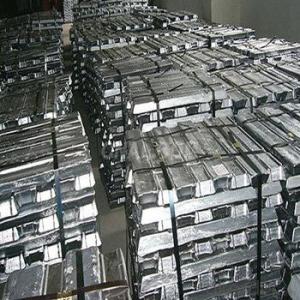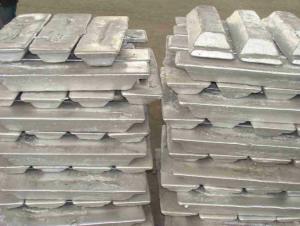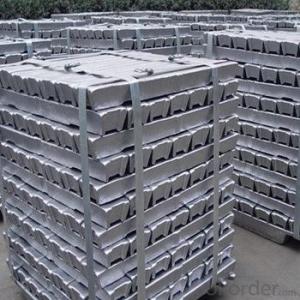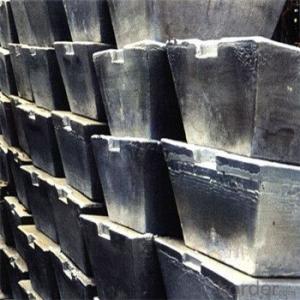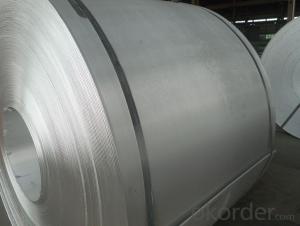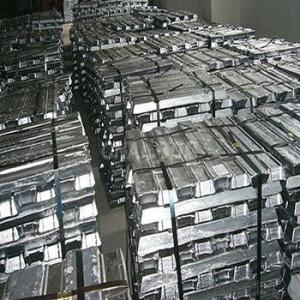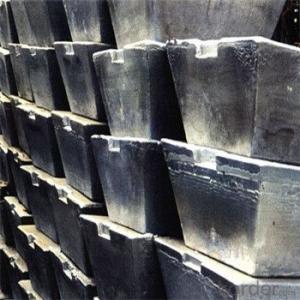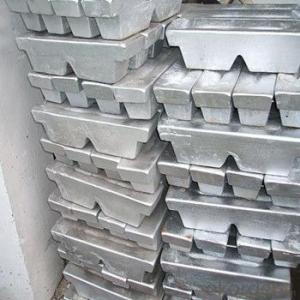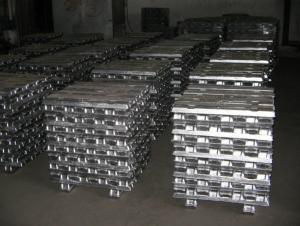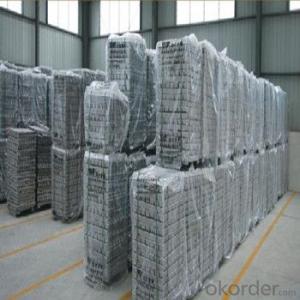Aluminum Ingot 99.7% From Factory Directly Supply With Cheap Price
- Loading Port:
- China main port
- Payment Terms:
- TT OR LC
- Min Order Qty:
- 1000 m.t.
- Supply Capability:
- 10000 m.t./month
OKorder Service Pledge
OKorder Financial Service
You Might Also Like
Pure Aluminum Ingot Used for Industry
1.Structure of Aluminum Ingot Description
Aluminum ingot for remelting is produced by molten salt electrolysis method using alumina and cryolite. Products meet the national standard GB/T1196-2002. The surface of ingot is clean and smooth. An ingot is a piece of material, usually metal, that is cast into a shape suitable for further processing. Insteelmaking, it is the first step among semi-finished casting products. Ingots usually require a second procedure of shaping, such as cold/hot working, cutting, or milling to produce a useful final product.
2.Main Features of the Aluminum Ingot
•High Purity
•High strength
•Fast melting
•Best price
•Good after-service
3. Aluminum Ingot Images


4. Aluminum Ingot Specification
Grade | Chemical Composition % | |||||||||
Al≥ | impurities ≤ | |||||||||
Si | Fe | Cu | Ga | Mg | Zn | Mn | others | Sum | ||
Al99.9 | 99.90 | 0.50 | 0.07 | 0.005 | 0.02 | 0.01 | 0.025 | - | 0.010 | 0.10 |
Al99.85 | 99.85 | 0.80 | 0.12 | 0.005 | 0.03 | 0.02 | 0.030 | - | 0.015 | 0.15 |
Al99.7 | 99.70 | 0.10 | 0.20 | 0.010 | 0.03 | 0.02 | 0.030 | - | 0.030 | 0.30 |
Al99.6 | 99.60 | 0.16 | 0.25 | 0.010 | 0.03 | 0.03 | 0.030 | - | 0.030 | 0.40 |
Al99.5 | 99.50 | 0.22 | 0.30 | 0.020 | 0.03 | 0.05 | 0.050 | - | 0.030 | 0.50 |
Al99.00 | 99.00 | 0.42 | 0.50 | 0.020 | 0.03 | 0.05 | 0.050 | - | 0.050 | 1.00 |
5.FAQ of Aluminum Ingot
We have organized several common questions for our clients,may help you sincerely:
①How about your company?
A world class manufacturer & supplier of castings forging in carbon steel and alloy steel,is one of the large-scale professional investment casting production bases in China,consisting of both casting foundry forging and machining factory. Annually more than 8000 tons Precision casting and forging parts are exported to markets in Europe,America and Japan. OEM casting and forging service available according to customer’s requirements.
②How to guarantee the quality of the products?
We have established the international advanced quality management system,every link from raw material to final product we have strict quality test;We resolutely put an end to unqualified products flowing into the market. At the same time, we will provide necessary follow-up service assurance.
③How long can we receive the product after purchase?
In the purchase of product within three working days, We will arrange the factory delivery as soon as possible. The pecific time of receiving is related to the state and position of customers.Commonly 7 to 10 working days can be served.
- Q:Wall aluminum window price
- Aluminum prices look at the price of aluminum ingot market. I wish you a pleasant life.
- Q:How are aluminum ingots used in the production of building facades?
- The production of building facades heavily relies on the essential properties and versatility of aluminum ingots. These ingots enable the creation of lightweight, durable, and aesthetically pleasing facades in modern architecture. To begin, aluminum ingots are melted and cast into various shapes and sizes according to the specific design requirements of the building facade. This casting process ensures that the aluminum can be easily manipulated and fabricated into different facade components. Once cast, the ingots can be extruded or rolled into sheets, panels, or profiles. These aluminum sheets or panels are then cut, shaped, and assembled to achieve the desired facade design. The malleability of aluminum allows for intricate designs and customization options, enabling architects to bring their creative visions to life. One of the major advantages of aluminum ingots in building facades is their lightweight nature. With a low density, aluminum is significantly lighter than other metals like steel. This characteristic reduces the overall weight of the facade, making installation easier and decreasing the load on the building structure. Moreover, the lightweight property of aluminum facilitates the creation of larger and more expansive facade designs, opening up greater design possibilities. Furthermore, aluminum ingots possess excellent corrosion resistance, a crucial attribute for building facades exposed to different weather conditions. The natural oxide layer that forms on the surface of aluminum protects it from rust and corrosion, ensuring the facade's longevity and durability. This resistance to corrosion reduces maintenance costs and extends the lifespan of the building facade. Additionally, aluminum ingots offer high thermal conductivity, which plays a significant role in effective thermal management for building facades. By helping regulate temperature and reducing energy consumption, aluminum facades contribute to sustainable building practices. These facades can also incorporate insulation materials to enhance energy efficiency. In terms of aesthetics, aluminum ingots provide a wide range of finishing options. They can be anodized, painted, or coated in various colors and textures to achieve the desired appearance. Aluminum facades can also be combined with other materials like glass or stone to create visually striking and modern facades that enhance the overall architectural design. In conclusion, the extensive use of aluminum ingots in building facades is due to their lightweight nature, corrosion resistance, thermal conductivity, and design versatility. These properties empower architects and designers to create durable, energy-efficient, and visually appealing facades that align with modern architectural trends.
- Q:What are the basic equipments for the production of aluminium ingots?
- If you want to match the very homogeneous ingot aluminum melting furnace, automatic machine, automatic folding spindle machine, environmental protection equipment, forklift, spectrum analyzer, loadometer, refining machine etc..
- Q:Does the pure aluminium ingot need to be removed in addition to the slag after melting?
- The pure aluminum ingot also needs to be removed in addition to the slag after melting. Because there will be air absorption in the process of melting, the slag will also be generated.
- Q:Process description of aluminium ingot
- Casting alloy ingots must be clarified for more than 30min. After cleaning, the slag can be cast. When casting, the furnace of the mixing furnace is aligned with the second and third moulds of the casting machine, so as to ensure the change of the liquid flow and a certain flexibility when changing the die. Furnace eyes and casting machine with a groove connection groove shorter is better, it can reduce the oxidation of aluminum, avoid vortex and splash, casting machine above disable 48h, restart, will die at 4h. The liquid aluminum mold with a shovel into the groove, the surface of liquid aluminum oxide film is removed, called slag. Flow with the first mock exam, will move down a chute mould casting machine is a continuous progress. The mould is moved in sequence, and the aluminum liquid is cooled gradually. When the casting machine reaches the middle of the casting machine, the aluminum liquid has been solidified into aluminium ingot, and the smelting number is printed by the printer. When the aluminum ingot reaches the top of the casting set, it has been completely solidified into aluminum ingot. At this time, the mold is turned over and the ingot is released and dropped on the automatic ingot car. The stacker is automatically stacked and bundled to become the finished aluminum ingot. The casting machine is cooled by spraying water, but must be started in the casting machine, turn full circle before water can be supplied. The aluminum liquid consumes about 8-10t water per ton, and a blower is needed to cool the surface in summer. The casting ingot belongs to the flat mold casting, the solidification direction of the aluminum liquid is from bottom to top, and the upper part is solidified at last, leaving a groove depression. The solidification time and the condition of each part of the aluminium ingot are different, so their chemical composition will be different, but it is in conformity with the standard as a whole.
- Q:The main raw material for aluminum smelting aluminum ingots from which into
- In our country the scrap aluminum recycling, about 1/5 from the packaging industry, the transportation industry from 2/5, 1/3 from the construction industry, recycling scrap cars produce scrap aluminum and aluminum cans are two important fields. China is the world's largest aluminum production and consumption country, with a large number of aluminum products into scrap, scrap recycling domestic future volume will continue to increase, and our dependence on imported scrap will also continue to reduce.
- Q:What are the challenges in recycling aluminum ingots?
- One of the challenges in recycling aluminum ingots is the energy-intensive process required to melt and extract aluminum from the ingots. Additionally, impurities such as coatings, paints, or other contaminants on the ingots can hinder the recycling process and require additional steps for purification. Furthermore, the collection and sorting of aluminum ingots from various sources can be logistically complex and time-consuming. Lastly, ensuring a consistent supply of high-quality aluminum ingots for recycling can be challenging, as it depends on factors like consumer behavior, recycling infrastructure, and market demand.
- Q:What are the different coating processes for aluminum ingots?
- There are several different coating processes that can be used for aluminum ingots. These processes are used to enhance the surface properties of the ingots and provide additional protection against corrosion and other environmental factors. Some of the common coating processes for aluminum ingots include: 1. Anodizing: This is a widely used coating process for aluminum. It involves creating an oxide layer on the surface of the ingots through an electrochemical process. Anodizing provides excellent corrosion resistance and can also enhance the appearance of the ingots by allowing for the application of dyes or paints. 2. Powder coating: In this process, a dry powder is applied to the surface of the aluminum ingots. The ingots are then heated, causing the powder to melt and form a protective coating. Powder coating provides a durable and aesthetically pleasing finish, offering resistance to corrosion, UV radiation, and chemicals. 3. Electrophoretic coating: This process involves immersing the aluminum ingots in a tank containing an electrically charged paint solution. The paint particles migrate and deposit on the surface of the ingots due to the electric field. Electrophoretic coatings offer excellent adhesion, corrosion resistance, and uniform coverage. 4. Chemical conversion coating: This process involves treating the aluminum ingots with a chemical solution that reacts with the surface to form a protective coating. Common chemical conversion coatings include chromate, phosphate, and chromate-phosphate coatings. These coatings provide corrosion resistance and can also serve as a base for paint or other decorative finishes. 5. Thermal spraying: In this process, a coating material is heated and sprayed onto the surface of the aluminum ingots. The coating material can be in the form of powders, wires, or rods. Thermal spraying creates a strong and durable coating that offers protection against wear, corrosion, and high temperatures. 6. Organic coatings: These coatings are typically applied as liquid paints or lacquers onto the surface of aluminum ingots. Organic coatings provide a decorative finish and also offer protection against corrosion and weathering. They are commonly used in applications where aesthetics are important. Each of these coating processes has its own advantages and disadvantages, and the choice of coating process depends on the specific requirements of the aluminum ingots and the intended application.
- Q:What are the energy requirements for producing aluminum ingots?
- Several factors, such as the production process, energy source, and facility efficiency, can influence the energy requirements for producing aluminum ingots. Generally, the production of aluminum ingots is known to be an energy-intensive process. The primary method used to produce aluminum ingots involves smelting aluminum oxide, or alumina, obtained from bauxite ore. The most commonly used method is the Hall-Héroult process, which includes electrolyzing alumina dissolved in a molten cryolite electrolyte. To carry out this process, a significant amount of energy is needed to heat the alumina to its melting point of approximately 2,040 degrees Celsius and maintain this temperature. Typically, large electric currents are passed through the molten electrolyte to provide the necessary energy for electrolysis. Moreover, the production of aluminum ingots requires a substantial amount of electrical energy to break the chemical bonds in alumina and separate the aluminum metal from the oxygen. The electrolysis process consumes significant electricity, making aluminum production one of the largest global consumers of electrical energy. The source of electricity used can also influence the energy requirements for producing aluminum ingots. Utilizing renewable energy sources like hydropower, wind power, or solar power can significantly reduce the environmental impact and carbon footprint of aluminum production. Conversely, if non-renewable sources like coal or natural gas are used to generate electricity, the energy requirements may increase, contributing to higher greenhouse gas emissions. Over the years, efficiency improvements and technological advancements have been made in aluminum production processes, resulting in reduced energy consumption. For instance, the introduction of pre-baked anode technology has enhanced the energy efficiency of the Hall-Héroult process. Additionally, recycling aluminum requires significantly less energy compared to primary production from bauxite ore, making it a more sustainable and energy-efficient option. In conclusion, the energy requirements for producing aluminum ingots are significant due to the high temperatures required for smelting and the electricity needed for electrolysis. However, technological advancements and the adoption of renewable energy sources can help decrease energy consumption and minimize the environmental impact of aluminum production.
- Q:What are the benefits of using aluminum ingots in the construction of lightweight structures?
- Using aluminum ingots in the construction of lightweight structures has several advantages. Firstly, aluminum is a lightweight metal, making it ideal for constructing lightweight structures. Its density is approximately one-third of steel, resulting in significantly lighter structures. This is especially beneficial in industries like aerospace, automotive, and marine, where reducing weight is crucial for enhancing fuel efficiency and overall performance. Secondly, aluminum is highly resistant to corrosion. Unlike other metals, such as steel, aluminum does not rust when exposed to moisture or corrosive elements. This makes it an excellent choice for structures exposed to harsh environmental conditions, like buildings near the coast or in areas with high humidity. By using aluminum ingots, structures can withstand corrosion, ensuring their longevity and reducing maintenance costs. Furthermore, aluminum is a highly malleable material, offering greater design flexibility. It can be easily shaped and formed into complex geometries, enabling architects and engineers to create innovative and aesthetically pleasing structures. This versatility in design also promotes efficient material use, minimizing waste and maximizing the structural integrity of lightweight constructions. Another significant benefit of using aluminum ingots is their excellent strength-to-weight ratio. Despite being lightweight, aluminum structures can still possess impressive strength and durability. This makes them suitable for applications where both strength and weight reduction are essential, such as in aircraft construction, high-rise buildings, and bridges. Additionally, aluminum is a sustainable material due to its high recyclability. It can be melted down and reprocessed repeatedly without losing its properties, making it an environmentally friendly choice. By using aluminum ingots, construction projects can contribute to the circular economy and reduce the demand for new raw materials. In conclusion, incorporating aluminum ingots into the construction of lightweight structures offers numerous benefits. These include reduced weight, corrosion resistance, design flexibility, excellent strength-to-weight ratio, and sustainability. By utilizing aluminum, construction projects can improve performance, enhance efficiency, and minimize environmental impact.
1. Manufacturer Overview |
|
|---|---|
| Location | |
| Year Established | |
| Annual Output Value | |
| Main Markets | |
| Company Certifications | |
2. Manufacturer Certificates |
|
|---|---|
| a) Certification Name | |
| Range | |
| Reference | |
| Validity Period | |
3. Manufacturer Capability |
|
|---|---|
| a)Trade Capacity | |
| Nearest Port | |
| Export Percentage | |
| No.of Employees in Trade Department | |
| Language Spoken: | |
| b)Factory Information | |
| Factory Size: | |
| No. of Production Lines | |
| Contract Manufacturing | |
| Product Price Range | |
Send your message to us
Aluminum Ingot 99.7% From Factory Directly Supply With Cheap Price
- Loading Port:
- China main port
- Payment Terms:
- TT OR LC
- Min Order Qty:
- 1000 m.t.
- Supply Capability:
- 10000 m.t./month
OKorder Service Pledge
OKorder Financial Service
Similar products
New products
Hot products
Hot Searches
Related keywords
